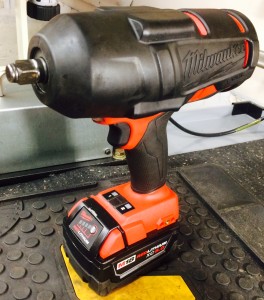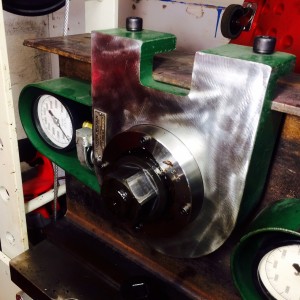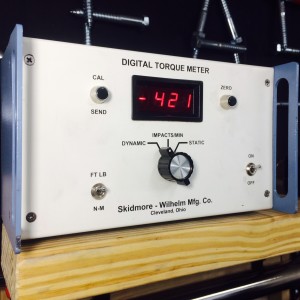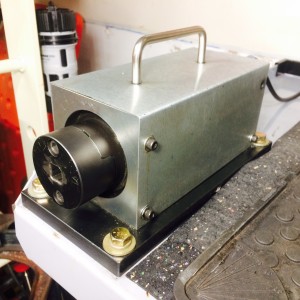As more impact wrenches continue to be released…..torque specs continue to become more questionable. Specifically, the huge numbers that we all see regarding “Nutbusting” or “Breakaway” Torque.
The problem with many manufacturers competing for your business, is that they all need to be the best. Typically this does not equate to size, weight, DBA levels, reliability, ease-of-use, etc — it boils down to torque. The common belief is more power = better. I disagree, and I will explain why the big number that you usually focus on (nutbusting torque) is a marketing scheme.
For this example I will be using one of the best cordless impact wrenches on the market — the Milwaukee M18 FUEL 2763 1/2″ High Torque Brushless Impact Wrench.
In previous videos I have tested the maximum forward & reverse “working torque” ratings using calibrated Skidmore Wilhelm units. Surprisingly, I achieved specs that were above the advertised ratings for the impact! The “working torque” reflects the maximum torque which can be achieved by tightening a large nut/bolt combination over a period of 15 seconds. Due to the extreme power levels of impact wrenches, most fasteners would stretch/deform/break under this extreme test, but we have specialized equipment which can handle those forces & give us extremely accurate results.
Milwaukee has 3 torque specs listed for the 2763 :
- Mode 1 = 100 ft-lbs
- Mode 2 = 700 ft-lbs
- Nutbusting = 1,100 ft-lbs
What they are not telling you is what the dynamic torque is (how hard it hits), how they achieved the working torque, or how they achieved the nutbusting torque.
We ran the impact on 3 different Skidmore Wilhelm units (2 regular & 1 electronic) to verify the actual torque specs. Measurements were taken for forward & reverse, both for dynamic torque & working torque. The results are interesting :
- Mode 1 Forward (Dynamic) = 161 ft-lbs
- Mode 2 Forward (Dynamic) = 422 ft-lbs
- Mode 1 Reverse (Dynamic) = 161 ft-lbs
- Mode 2 Reverse (Dynamic) = 421 ft-lbs
- Max Forward Working Torque = 862 ft-lbs
- Max Reverse Working Torque = 1,036 ft-lbs
This leaves “nutbusting” torque. They claim 1,100 ft-lbs…..but looking at the numbers above, it is not lining up. Why?
Basically, the term “nutbusting” torque / “breakaway” torque is a creative marketing term to make an impact appear more powerful than it actually is. There are two ways of coming up with this number — using a larger/more powerful impact OR using a very large torque wrench.
The larger impact wrench method would be done by using the more powerful tool to tighten a nut/bolt over the maximum torque which the impact being tested could achieve on it’s own (for example — 1,100 ft-lbs). The tester would then take the lesser-powered impact and would immediately try and remove the nut/bolt. If successful, it would be repeated at a higher torque spec until the lower powered unit could no longer remove it.
The torque wrench method would be identical, but rather than using an impact to tighten the bolt — the tester would instead use the torque wrench (at specific torque settings) to tighten a bolt. The tester would then remove it with the impact wrench & repeat.
The “nutbusting” / “breakaway” rating would derive from the max torque spec which the impact could remove the nut/bolt. However, there is a big problem with this…..
When a nut/bolt is hot, it takes LESS TORQUE to remove it than it took to install it! So, if you tighten to 1,000 ft-lbs…..800 ft-lbs can remove it immediately afterwards. The torque is 800 ft-lbs “reverse torque“….not 1,000 ft-lbs “nutbusting torque“. But to the marketing dept, they choose to go with the higher number in order to look better.
What does this mean?
It means that when you see huge numbers on the side of a box — dont always believe them. There are ZERO regulations/standards when it comes to testing torque. We have seen many companies strive to be 100% honest & not mislead customers…..but we have also seen many companies grossly overstate what their torque specs are in order to make a quick buck. (Remember — running the same impact on the Skidmore for different time lengths, will inevitably cause different results.)
When buying an impact, the working torque (usually published) & dynamic torque (usually not published) are the important numbers. The nutbusting/breakaway torque specs should be ignored — it is nothing but a marketing gimmick.
Check out the video to see for yourself!




